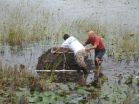(Press-News.org) Foreign invaders such as pythons and lionfish are not the only threats to Florida's natural habitat. The native Carolina Willow is also starting to strangle portions of the St. Johns River.
Biologists at the University of Central Florida recently completed a study that shows this slender tree once used by Native Americans for medicinal purposes, may be thriving because of water-management projects initiated in the 1950s. Canals were built to control runoff and provide water for agriculture. The unintended consequence -- stable water levels -- allowed Carolina Willow to spread and thrive.
They now cover thousands of acres. Willows form impenetrable thickets that prevent boating and eliminate duck habitat. Willow thickets also use tremendous amounts of water, leaving less available for wildlife and people.
The findings were published today in Restoration Ecology, the peer-reviewed journal of the Society for Ecological Restoration. The St. Johns Water Management District funded the study.
While the trees previously were kept in check by natural annual flooding, they can now be found thriving in wetlands, swamps and marshes. Some trees grow as tall as 35 feet. The leaves of the tree contain salicin, which is the compound behind the pain-relieving effect of salicylic acid found in aspirin.
UCF professors Pedro F. Quintana-Ascencio and John Fauth worked with Kimberli Ponzio and Dianne Hall, scientists from the St. Johns River Water Management District, to run experiments that found ways to control the willow, which is taking over marshes in the upper St. Johns River basin.
UCF students helped plant hundreds of willow seedlings and saplings onto small islands built for the project by the St. Johns River Water Management District's staff. Willows planted low on the islands drowned during summer floods, but plants above the waterline grew and flowered one year later.
The biologists confirmed the importance of water fluctuation using experimental ponds on UCF's main campus. Willow seedlings and saplings planted on the pond banks grew poorly when the biologists raised the water level and flooded the plants for several months. At the same time, control plants just above the waterline grew over 3 feet tall.
Combined, the two experiments show that the key to controlling willow is allowing water levels to fluctuate in early spring. Seedlings and small saplings cannot survive dry conditions and are easily drowned in wet marshes. Once plants become larger, willows can survive droughts and tolerate floods and are very difficult to eradicate, Fauth said.
Based on the conclusions of the study, the UCF biologists are helping scientists at the water district develop new ways to reduce willow cover and slow down the expansion, Fauth said.
"It's important that these trees be controlled to maintain water quality and availability, conserve wildlife and continue enjoying recreational activities in the river, " Fauth said.
The study may also aid other countries fighting the Carolina willow, including Australia and South Korea where they were introduced for erosion control.
Quintana-Ascencio joined UCF in 2003 after working at El Colegio de la Frontera Sur, in San Cristóbal de Las Casas, Chiapas, Mexico. He has a Ph.D. in ecology and evolution from State University of New York at Stony Brook. He has been a guest scholar at institutions around the world including the University of Melbourne in Victoria, Australia, and the Universidad Rey Juan Carlos in Madrid, Spain. He also has earned several fellowships and has published more than 60 articles and book chapters.
Fauth also joined UCF in 2003. Previously he had worked at the College of
Charleston and at Denison University. He has a Ph.D. in zoology from Duke University. He has written more than 35 articles and book chapters. He also
serves on several boards and was a founding member of the Coral Disease and
Health Consortium.
INFORMATION:
Other contributors to the study include: former UCF biology student Luz M. Castro Morales and Ken Snyder of the St. Johns River Water Management District.
50 Years of Achievement: The University of Central Florida, the nation's second-largest university with nearly 60,000 students, is celebrating its 50th anniversary in 2013. UCF has grown in size, quality, diversity and reputation, and today the university offers more than 200 degree programs at its main campus in Orlando and more than a dozen other locations. Known as America's leading partnership university, UCF is an economic engine attracting and supporting industries vital to the region's success now and into the future. For more information, visit http://today.ucf.edu.
Pythons, lionfish and now willow invade Florida's waterways
2013-01-09
ELSE PRESS RELEASES FROM THIS DATE:
Obesity drops among children enrolled in NY state WIC nutrition program
2013-01-09
New York children participating in a federal nutrition program had healthier eating behaviors and lower rates of obesity two years after improvements to the program were undertaken, according to a study published online today in Obesity, the official journal of the Obesity Society.
In 2009 all 50 states rolled out sweeping changes to the menu of foods available through the Special Supplemental Nutrition Program for Women, Infants, and Children, or WIC, which reaches nearly half of all infants born in the United States. New York was the first state in the nation to roll ...
Inside DayGlo: A video tour of the world's most colorful factory
2013-01-09
A new American Chemical Society (ACS) video provides a behind-the-scenes-look at the DayGlo Color Corp. factory, producer of the fluorescent paints that light up traffic cones, black light posters, hula-hoops and other products. The video, the latest episode of the award-winning Bytesize Science series from the world's largest scientific society, is at www.BytesizeScience.com.
Inside DayGlo opens with a brief history of the company, which has been designated as an ACS National Historic Chemical Landmark, and continues with an in-depth look inside its main production ...
Testing Einstein's E=mc2 in outer space
2013-01-09
With the first explosions of atomic bombs, the world became witness to one of the most important and consequential principles in physics: Energy and mass, fundamentally speaking, are the same thing and can, in fact, be converted into each other.
This was first demonstrated by Albert Einstein's Theory of Special Relativity and famously expressed in his iconic equation, E=mc2, where E stands for energy, m for mass and c for the speed of light (squared).
Although physicists have since validated Einstein's equation in countless experiments and calculations, and many technologies ...
Researchers try new approach for simulating supernovas
2013-01-09
VIDEO:
This is a computer simulation of one octant of a core collapse supernova, using SNSPH.
Click here for more information.
Two University of Texas at Arlington researchers want to bridge the gap between what is known about exploding stars and the remnants left behind thousands of years later. So they're trying something new – using SNSPH, a complex computer code developed at Los Alamos National Laboratory.
On Tuesday, Carola I. Ellinger, a post-doctoral researcher at ...
Bottom-up approach provides first characterization of pyroelectric nanomaterials
2013-01-09
By taking a "bottom-up" approach, researchers at the University of Illinois at Urbana-Champaign have observed for the first time that "size does matter" in regards "pyroelectricity"—the current/voltage developed in response to temperature fluctuations that enables technologies such as infrared sensors, night-vision, and energy conversion units, to name a few.
"Controlling and manipulating heat for applications such as waste heat energy harvesting, integrated cooling technologies, electron emission, and related functions is an exciting field of study today," explained ...
Weight counseling decreases despite rise in obesity
2013-01-09
HERSHEY, Pa. -- While the number of overweight and obese Americans has increased, the amount of weight counseling offered by primary care physicians has decreased -- especially for patients with high blood pressure and diabetes -- according to Penn State College of Medicine researchers.
More than 145 million adult Americans are overweight or obese.
Researchers analyzed data from the National Ambulatory Medical Care Survey for the years 1995-1996 and 2007-2008. This national survey collects information about the provision and use of outpatient medical care services in ...
First 'bone' of the Milky Way identified
2013-01-09
Our Milky Way is a spiral galaxy - a pinwheel-shaped collection of stars, gas and dust. It has a central bar and two major spiral arms that wrap around its disk. Since we view the Milky Way from the inside, its exact structure is difficult to determine.
Astronomers have identified a new structure in the Milky Way: a long tendril of dust and gas that they are calling a "bone."
"This is the first time we've seen such a delicate piece of the galactic skeleton," says lead author Alyssa Goodman of the Harvard-Smithsonian Center for Astrophysics (CfA). Goodman presented the ...
Mayo Clinic: 2-drug combination may slow deadly thyroid cancer
2013-01-09
ROCHESTER, Minn. -- A combination of the drugs pazopanib and paclitaxel shows promise in slowing anaplastic thyroid cancer (ATC), according to a Mayo Clinic-led study published in the journal Science Translational Medicine. The two drugs together resulted in greater anti-cancer activity in ATC than either drug alone, says lead researcher Keith Bible, M.D., Ph.D., a Mayo Clinic oncologist.
Anaplastic thyroid cancer is a rare but devastating form of thyroid cancer that typically strikes men and women in their 60s and 70s. It is very aggressive, with a median survival ...
Cluster mission indicates turbulent eddies may warm the solar wind
2013-01-09
The sun ejects a continuous flow of electrically charged particles and magnetic fields in the form of the solar wind -- and this wind is hotter than it should be. A new study of data obtained by European Space Agency's Cluster spacecraft may help explain the mystery.
The solar wind is made of an electrically-charged gas called plasma. One theory about the wind's puzzling high temperatures is that irregularities in the flow of charged particles and magnetic fields in the plasma create turbulence, which, in turn, dissipates and adds heat to its surroundings. Using two separate ...
NASA sees Tropical Cyclone Narelle form in Southern Indian Ocean
2013-01-09
The eighth tropical cyclone to form during the Southern Indian Ocean cyclone season formed from low pressure System 98S and became Tropical Cyclone Narelle. NASA's TRMM satellite passed over System 98S and saw the hallmark "hot towers" that indicated the storm would soon likely intensify into Tropical Storm Narelle.
NASA's Tropical Rainfall Measuring Mission (TRMM) satellite passed over System 98S on Jan. 7 at 0901 UTC (4:01 a.m. EST/U.S.) hours before it intensified into Tropical Storm Narelle.
TRMM's Precipitation Radar instrument captured estimates of rainfall occurring ...



